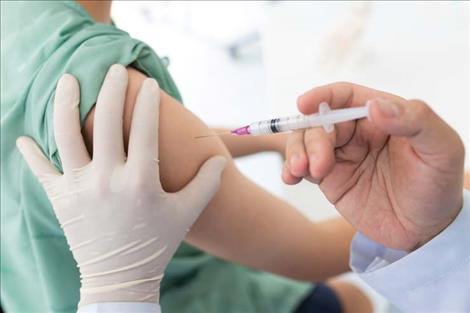Local gets COVID-19 vaccine, officials plan for future
Hey savvy news reader! Thanks for choosing local.
You are now reading
1 of 3 free articles.
Teri Lynn Miller, a St. Ignatius paramedic, was one of the first people in the Mission Valley to receive a coronavirus vaccine. She joined more than 3,000 Montana health care workers who received the injection last week at 10 Montana hospitals.
“I kind of scooted out of the normal lane to get it,” she said in an interview last Friday. A friend who’s a dental hygienist sent her a link to register and Miller was able to get an injection of the recently approved Pfizer-BioNTech COVID-19 vaccine last Thursday at Kalispell Regional Medical Center.
A day later, she reported that her arm was sore, she felt achy and had a mild headache. “I feel kind of crappy today, but not too bad.” She receives a booster Jan. 7.
Miller said the process was very smooth and well organized. She was given a time slot in advance and waited outside in her vehicle until she was summoned into the hospital meeting room via text message, and in the meeting room, a large cadre of medical personnel manned around 10 vaccine stations. “It was very efficient – I was impressed.”
Miller was a volunteer EMT in St. Ignatius for many years and now works part time as a paramedic for Polson Ambulance, which provides emergency services in Lake County. She also works for the state Department of Natural Resources and Conservation during wildfire season and served as a COVID-19 specialist last summer with the Northern Rockies Incident Management Team in Colorado.
As a younger woman, Miller had a severe lung condition called spontaneous pneumothorax, which periodically caused her lungs to collapse, complicated by some untreated allergies. Asthma medication has helped her recover.
“I don’t have lung issues any more,” she said. “But who wants to test that with COVID?”
The virus and her preexisting health condition make her reluctant to work on ambulance crews, although she does fill in occasionally.
“I’m afraid of COVID, so I only work when someone gives up a shift,” she said. According to Miller, the ambulance service has been transporting a few COVID patients a week and several staff members have tested positive for the virus. Like many in the medical profession, she sees the vaccine as “the light at the end of tunnel.”
Governor Steve Bullock announced last Friday that the second batch of Pfiizer’s COVID-19 vaccine, set to be unleashed this week, will target healthcare workers at rural hospitals and staff and residents of nearly 300 long-term care facilities. Bullock also said that the federal government has reduced anticipated allocation of vaccine doses through the end of the year by 20 percent across the nation, meaning Montana can expect around 48,000 doses instead of 60,000.
The federal government is contracting with CVS, Walgreens and Big Sky Managed Care Pharmacy to offer on-site COVID-19 vaccination services for nursing homes and assisted living facilities.
The state also expects to receive 18,300 doses of the newly approved Moderna vaccine this week, which will be shipped to critical access hospitals and community health centers for healthcare workers on the frontlines of the pandemic.
The most recent addition to the COVID arsenal packages 100 doses per box and does not need the ultra-cold storage that Pfizer’s requires, making it more convenient in rural settings or small facilities. The Pfizer vaccine must be stored at temperatures of -80°F or below, while the Moderna vaccine must be stored at -48°F.
The University of Montana in Missoula announced, last week, that the school has been approved as a vaccine holding and distribution center. With three existing subzero freezers available to store the Pfizer vaccine and a fourth arriving next month, UM earned approval to house and distribute the lifesaving doses from the U.S. Centers for Disease Control and the Montana State Department of Public Health and Human Services.
UM plans to deploy its many UM pharmacy alumni and current pharmacy students for vaccine rollout and immunizations and will pilot a drive-through vaccination program.
“Later, as more vaccines become available, we’ll be organizing a statewide delivery program to our rural communities, hospitals and pharmacies,” said Kenneth Chatriand, manager of the UM Pharmacy, in a recent press release.
According to Tribal Health’s Community Health Division Director Chelsea Kleinmeyer, the Confederated Salish and Kootenai Tribes expects to receive up to 100 doses this week, which will be used to vaccinate frontline healthcare workers, including nurses, medical clinicians, pharmacists, dental staff and elder care workers. Tribal Health has access to one of the super-cold freezers at Salish Kootenai College, with a second freezer on order.
She notes that while some healthcare workers are reluctant to get the vaccine, most are on board. “Tribal Health is offering opportunities for employees to be educated about the vaccine and ask questions before deciding to receive it or not,” she added.
Lake County Public Health Director Emily Colomeda said she’s uncertain when her department will receive its first round of vaccine. “And we may not initially,” she added. “We don’t have frontline nurses who are at high risk for contracting COVID working here.”
She told the Lake County Board of Health at last week’s meeting that the vaccine probably will not be available to the general public until March or April.
“We still have a long ways to go in this pandemic,” she added, cautioning the public to continue to mask up, keep socially distanced and avoid large holiday gatherings.
















